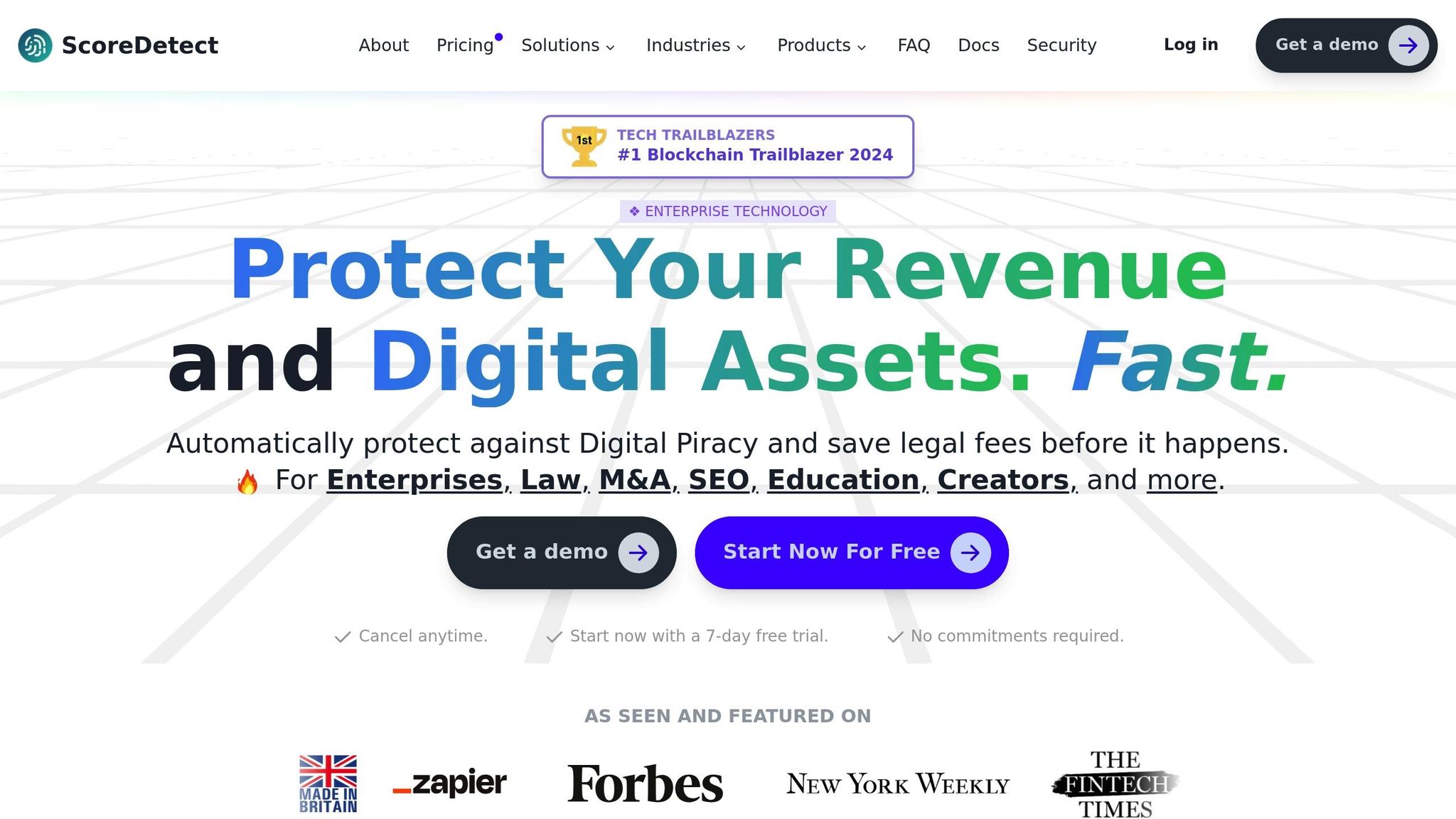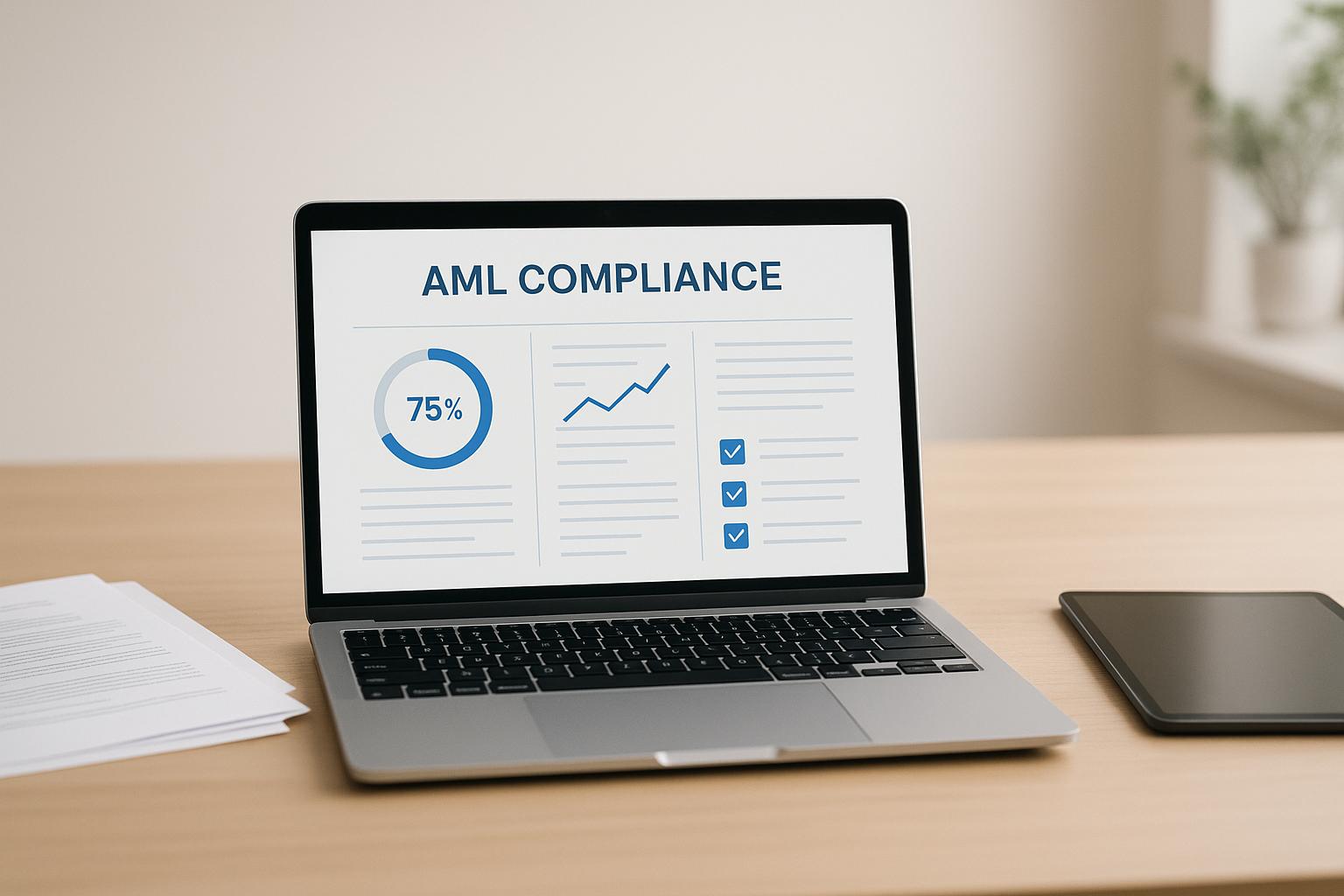Web crawlers, or bots, are automated tools that scan, collect, and index online content. They’re essential for real-time data processing, allowing businesses to monitor, analyze, and act on information as it’s generated. From detecting fraud to tracking news updates, these tools power fast decision-making in a constantly changing digital landscape.
Key points:
- Web Crawlers: Automate data collection from websites using technologies like HTTP requests and JavaScript rendering.
- Real-Time Processing: Delivers instant insights for tasks like fraud detection, inventory tracking, and copyright monitoring.
- AI Integration: Modern crawlers use AI to adapt to website changes, automate scraping, and improve accuracy.
- Anti-Piracy: Tools like ScoreDetect use crawlers to identify and act on copyright violations efficiently, issuing takedown notices with a 96% success rate.
Web crawlers combined with platforms like Apache Kafka ensure fast, accurate, and actionable data streams, making them indispensable for businesses in media, finance, and e-commerce.
Core Functions and Technologies Behind Web Crawlers
Main Functions of Web Crawlers
Web crawlers play a vital role in gathering and organizing data from the web. They automatically navigate through websites, following links to collect text, images, and metadata. This process delivers structured data that’s ready for analysis, making it invaluable for a variety of applications.
Modern crawlers utilize scheduling and prioritization to focus on the most important pages first. With distributed infrastructures, they can process thousands – or even hundreds of thousands – of pages per second. This speed and efficiency power tasks like monitoring competitor pricing, tracking inventory, and aggregating breaking news almost instantly. These core functions provide the backbone for technologies that make real-time data processing possible.
Technologies That Enable Real-Time Crawling
Several technologies work together to ensure the speed and reliability of real-time crawling. Proxy rotation is key, as it distributes requests across multiple IP addresses, ensuring uninterrupted access to websites even when access restrictions are in place. Rate limiting helps manage the frequency of requests based on server responses, balancing efficiency with server load to avoid disruptions.
To capture dynamic content, crawlers now use JavaScript rendering through headless browsers. Distributed crawling architectures further boost performance by dividing tasks across multiple servers or nodes. Additionally, techniques like HTTP caching and conditional requests keep data up to date while minimizing bandwidth usage. These technologies collectively enable faster and more efficient crawling, setting the stage for advanced tools powered by AI and automation.
AI and Automation in Web Crawling
Artificial intelligence and automation have revolutionized web crawling, making it smarter and more efficient. AI-powered crawlers can adapt to website changes, extract structured data, and adjust their methods without requiring manual intervention. Advanced AI tools now design, test, and refine scraping algorithms, reducing the need for manual coding while improving accuracy.
Features like semantic segmentation and content filtering allow crawlers to zero in on relevant information, ignoring distractions like ads or navigation elements. Some systems even perform multi-hop reasoning, connecting related data from different websites to build comprehensive datasets – an essential feature for market research and competitive intelligence. Integration with platforms like Apache Kafka enables real-time data processing, deduplication, and transformation, streamlining workflows and improving data accuracy.
One standout example is ScoreDetect, a platform that leverages advanced AI and automation to excel in digital content management. With a 95% success rate in bypassing website prevention measures, ScoreDetect integrates with over 6,000 web apps, offering seamless real-time monitoring and protection. It showcases how modern web crawlers can connect with business systems to provide robust monitoring and protection for digital assets. These advancements highlight how AI and automation are reshaping web crawling for the future.
Applications in Digital Content Management and Anti-Piracy
Protecting Digital Assets with Real-Time Crawling
Real-time web crawlers serve as a frontline defense against digital piracy, constantly scanning online platforms to spot unauthorized content distribution. This proactive monitoring enables swift detection of copyright violations, helping to mitigate damage before it escalates [1].
This approach has proven particularly effective for media companies. For example, when new content is released, real-time crawlers can quickly identify pirated versions, giving rights holders the chance to act before the material spreads to multiple platforms [1]. This is especially useful in industries where content turnover is fast-paced.
The process works by targeting specific online sources and setting up crawlers to look for distinct content markers like watermarks, metadata, or unique text patterns. These advanced systems can handle massive amounts of data in real time, ensuring that actionable insights are available almost instantly for enforcement decisions [3]. Industries such as media, education, and software development depend on these tools to safeguard their digital assets. For instance, software companies use them to track unauthorized code sharing, while marketing agencies rely on them to protect campaign materials from misuse.
How Automated Anti-Piracy Workflows Work
Automation has revolutionized anti-piracy efforts, turning what was once a slow, manual process into a highly efficient system capable of tackling violations on a large scale. When a web crawler flags suspected copyright infringement, automated workflows take over.
These workflows cross-check the flagged content against asset databases, using AI to confirm violations. Once verified, they issue takedown notices almost instantly, dramatically reducing response times. This speed is crucial for minimizing revenue loss, as organizations can now address issues within minutes. Automated systems can handle hundreds or even thousands of cases simultaneously – something manual methods simply can’t achieve. They also include features like tracking and escalation, which monitor the progress of takedown requests and automatically follow up if hosting providers fail to act within a set timeframe. These persistent mechanisms ensure that actions are completed rather than getting bogged down in delays.
Platforms like Apache Kafka further enhance these workflows by enabling real-time data processing, validation, and filtering. This ensures that only accurate and relevant information triggers enforcement actions, reducing the risk of false positives and maintaining good relationships with legitimate content distributors [3].
How ScoreDetect Uses Web Crawlers

ScoreDetect exemplifies how automated anti-piracy workflows can be seamlessly integrated into a single platform. By leveraging real-time data extraction, ScoreDetect combines prevention, discovery, analysis, and enforcement into a streamlined process that showcases the power of web crawling in protecting digital assets.
During the discovery phase, ScoreDetect uses highly targeted web scraping techniques to bypass anti-crawling measures with a 95% success rate [1]. Once potential violations are identified, the platform’s analysis tools compare the flagged content with original assets, providing the hard evidence needed for legal action and takedown requests.
Enforcement is where ScoreDetect truly shines. The platform automates the creation of legally formatted delisting notices, achieving a 96% takedown success rate – far exceeding traditional manual methods [1]. This efficiency is supported by the platform’s ability to present compelling evidence that hosting providers can process quickly.
ScoreDetect also incorporates blockchain technology to enhance its capabilities. By capturing checksums of original content instead of storing the actual files, it provides verifiable proof of ownership while maintaining data security. Additionally, integration with over 6,000 web apps via Zapier ensures smooth workflow automation across various business systems.
Another standout feature is ScoreDetect’s invisible watermarking technology. These markers remain detectable even if the content is altered or redistributed, allowing web crawlers to trace ownership and ensure accountability. The platform is used across diverse sectors, including media companies protecting streaming content, academic institutions safeguarding research, legal firms securing sensitive documents, and ecommerce businesses monitoring product images. This versatility makes ScoreDetect an essential tool for modern digital asset protection.
Challenges and Future Trends in Real-Time Web Crawling
Common Web Crawling Challenges
Real-time web crawling comes with its fair share of hurdles, many of which can disrupt effective data collection. One of the biggest challenges is dealing with anti-bot defenses. Websites often deploy tactics like CAPTCHAs, IP blocking, and dynamic content loading to block automated crawlers from accessing their data [4][5].
Scalability is another major issue. Crawlers need to process millions of pages across countless websites without overloading servers or missing critical updates. This is especially tricky when monitoring fast-changing digital environments.
Then there’s the problem of data quality. Websites frequently update their layouts, adopt new technologies, or use complex JavaScript frameworks. These changes can confuse traditional crawlers, leading to incomplete or messy data that often requires extensive manual cleanup.
Finally, compliance with regulations like GDPR and CCPA adds another layer of complexity. Crawlers must respect user consent and adhere to site-specific restrictions, all while maintaining speed to avoid triggering anti-bot measures [4]. These challenges have pushed developers to rethink and innovate web crawling techniques.
Future Trends in Real-Time Crawling
The difficulties faced in real-time web crawling are driving exciting advancements in the field. Artificial intelligence and automation are at the forefront of this evolution. For example, AI-driven crawlers now use machine learning to optimize scheduling, semantic segmentation to pinpoint relevant content, and adaptive algorithms to navigate ever-changing website structures [5].
Modern systems powered by AI can also autonomously create, test, and refine web scraping scripts. This significantly reduces the need for manual intervention while boosting both speed and accuracy. It’s a big leap from traditional, rule-based methods to systems that can learn and adapt in real time [3].
Real-time data processing has also seen improvements through integration with tools like Apache Kafka. These platforms allow crawlers to validate, deduplicate, and transform data as it’s collected, ensuring that users receive only accurate and relevant information [3].
Another trend is the rise of multi-hop reasoning, which allows crawlers to connect data from multiple sources. This creates structured and verifiable outputs, paving the way for more sophisticated analytics. These advancements are making crawlers smarter, more efficient, and better equipped to handle complex tasks [5].
Traditional vs. New Technologies Comparison
Here’s a side-by-side look at how traditional crawlers stack up against modern, AI-driven solutions:
| Feature | Traditional Crawlers | AI/Blockchain-Enabled Crawlers |
|---|---|---|
| Anti-bot Evasion | Basic, often blocked | Advanced AI, highly effective |
| Data Extraction | Manual, rule-based | Automated, semantic, context-aware |
| Scalability | Limited, fragile scripts | Resilient, cloud-based, distributed |
| Data Quality | Messy, needs cleanup | Clean, structured, ready-to-use |
| Compliance | Minimal, risky | Privacy-first, built-in safeguards |
| Copyright Verification | None | Blockchain-based, verifiable |
| Automation | Low | High, supports workflows |
| Adaptability | Breaks with site changes | Self-healing, autonomous |
| Dynamic Content | Poor (static HTML only) | Full JS rendering, lazy load support |
These advancements not only improve compliance and data quality but also ensure the efficiency needed for real-time, high-quality data streams.
sbb-itb-738ac1e
Design a Web Crawler System Design Interview w/ a Ex-Meta Staff Engineer
Conclusion
Wrapping up the discussion, let’s highlight some key insights into real-time web crawling and its role in safeguarding digital assets.
Key Takeaways
Real-time web crawlers have revolutionized how organizations handle data by enabling instant monitoring, analysis, and response to changes across digital platforms. These automated tools provide critical, up-to-date information that supports decision-making, compliance, and operational efficiency in industries like media, education, ecommerce, and legal services[1][2].
The integration of AI and blockchain has pushed web crawling beyond basic data collection. AI enhances the ability to filter and prioritize data, ensuring greater precision in detecting unauthorized content use[1][6]. Blockchain, on the other hand, offers tamper-proof records of content ownership, facilitating automated anti-piracy measures without the need to store actual digital files[1].
In today’s fast-paced digital world, real-time crawling is essential for spotting and addressing threats as they arise. Organizations can now detect and respond to unauthorized content use instantly, helping to reduce revenue losses and protect their reputations. This capability is indispensable in an environment where content can be duplicated and distributed within minutes of publication[1].
Furthermore, the efficiency of AI-powered tools allows for rapid deployment of scraping codes, cutting setup times from weeks to mere minutes[3]. These advancements ensure consistent, reliable monitoring of digital assets, making real-time crawling a cornerstone of modern content protection strategies.
Why Choose ScoreDetect
ScoreDetect excels in delivering cutting-edge solutions for digital content protection. With a success rate of over 95% in bypassing anti-crawling defenses and 96% effectiveness in executing automated takedown notices, it’s a standout choice for businesses facing digital threats[1].
One of ScoreDetect’s key strengths is its blockchain integration, which provides verifiable proof of ownership while maintaining privacy by not storing actual files. This approach enhances copyright protection without compromising security[1].
The platform’s comprehensive automation capabilities set it apart. From invisible watermarking and smart content discovery to automated analysis and takedown workflows, ScoreDetect handles it all. Its seamless integration with leading web applications ensures efficient workflow automation and real-time protection tailored to the needs of modern digital businesses[1].
With proven technology, advanced automation, and unmatched success rates, ScoreDetect equips organizations to stay ahead in the fight against digital content misuse.
FAQs
How do web crawlers use AI to adapt to website changes and collect accurate data?
Web crawlers use AI-powered algorithms to stay on top of changes in website structures, ensuring data collection stays accurate and efficient. These algorithms analyze patterns, page layouts, and content updates, allowing crawlers to navigate complex, dynamic websites. They can even handle obstacles like anti-bot systems and CAPTCHA challenges.
AI also plays a key role in making crawling more efficient. It helps prioritize important pages, cut down on duplicate data collection, and speed up the entire data processing workflow. This ability to adjust quickly is essential for keeping insights up to date and supporting tasks such as managing digital content and protecting copyrights.
What challenges do web crawlers face in real-time data processing, and how are new technologies helping to overcome them?
Web crawlers face a tough job when it comes to real-time data processing. They need to manage enormous amounts of information from countless websites, deal with dynamic content or access restrictions, and keep everything updated promptly – all without overwhelming servers. These challenges can slow down the process and reduce the accuracy of the data they collect.
Fortunately, advancements in technology are tackling these hurdles head-on. AI-powered algorithms are making navigation smarter, while adaptive crawling techniques help bypass restrictions more effectively. Additionally, cloud-based infrastructure provides scalable solutions for handling large-scale data processing with ease. Take tools like ScoreDetect, for instance. They combine advanced web scraping methods with AI to uncover and analyze digital content efficiently, all while adhering to website protocols. These innovations make data collection faster and more dependable, paving the way for real-time insights and improved digital content management.
How does blockchain technology improve the ability of web crawlers to protect digital content?
Blockchain technology improves the security of digital assets by generating a checksum – a unique digital fingerprint for the content. This approach protects copyrights without the need to store the actual digital files themselves.
When combined with blockchain, web crawlers can verify content ownership in a way that’s both reliable and resistant to tampering. This extra layer of protection not only helps shield digital assets but also streamlines the process of detecting and addressing unauthorized use.

